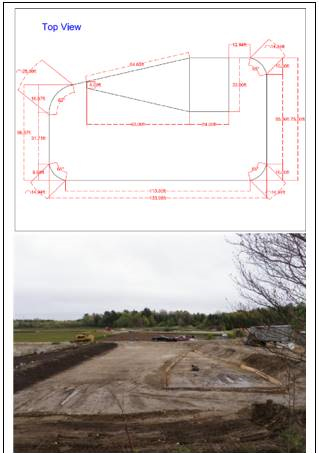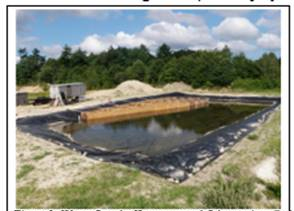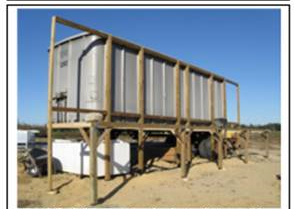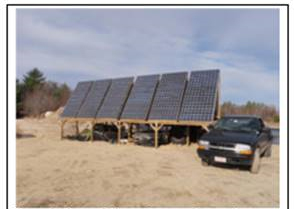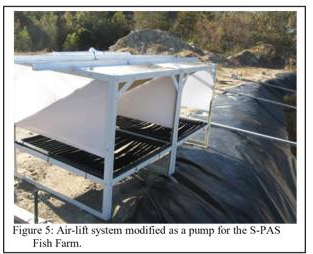Grantee Research Project Results
2011 Progress Report: Developing Alternative Power to Drive a Partitioned Aquaculture System for Intensive Food Fish Production
EPA Grant Number: SU834755Title: Developing Alternative Power to Drive a Partitioned Aquaculture System for Intensive Food Fish Production
Investigators: Leavitt, Dale F. , Riley, Linda A. , Thomas, Charles R. , Roy, Adam , Thomas, Sarah , McAskill, Mata , Reynolds, Thomas , Hild, Tyler , Elefante, Daniel , Futoma, Elizabeth , Pettit, Rebecca , Grodeska, Stephanie , Sylvester, Brianna , Farrington, Christopher , Garlasco, John , Szczepanek, Nathan , Richard, Andrew
Current Investigators: Leavitt, Dale F. , Riley, Linda A. , Thomas, Charles R. , Boisclair, Joshua , Pica, Jessica , Roy, Adam , Schork, George , Thomas, Sarah , McAskill, Mata , Reynolds, Thomas , Hild, Tyler , Elefante, Daniel , Futoma, Elizabeth , Pettit, Rebecca , Grodeska, Stephanie , Sylvester, Brianna , Farrington, Christopher , Garlasco, John , Szczepanek, Nathan , Richard, Andrew
Institution: Roger Williams University
EPA Project Officer: Page, Angela
Phase: II
Project Period: July 7, 2010 through December 31, 2012
Project Period Covered by this Report: August 15, 2010 through December 31,2011
Project Amount: $74,786
RFA: P3 Awards: A National Student Design Competition for Sustainability Focusing on People, Prosperity and the Planet - Phase 2 (2010) Recipients Lists
Research Category: Pollution Prevention/Sustainable Development , P3 Awards , P3 Challenge Area - Sustainable and Healthy Communities , Sustainable and Healthy Communities
Objective:
It is incumbent on the developed nations to improve and expand our capacity to produce food in an environment that is sustained for future generations. One production strategy that has high potential for providing food is aquaculture. Our challenge is the refinement of an intensive recirculating pond-based aquaculture production system (the Partitioned Aquaculture System - PAS) such that it is driven by low-impact renewable energy sources. We proposed to construct, evaluate, and optimize a system to remove the need for commercial electrical power to the PAS by installing photovoltaic electrical production supplying a battery-based power source to drive an airlift pump circulator.
Progress Summary:
Summary of Findings: The following bulleted results have been achieved to date:
Figure 1. Plans for the pond construction (A) and the
footprint of the pond following excavation (B).
1.
Pond construction:
a. Excavation of the pond area was delayed due to availability of the excavating company until the week of 28 April 2011. It took approximately two weeks for the excavation to be completed, as designed (Figure 1).
b. Installation of the pond liner was completed 13 July 2011.
c. Construction of the fish holding area and the water inflow baffle system was completed on 23 Aug. 2011 (Figure 2).
d. 500 (7” tail length) largemouth bass were moved into the system over a one- month period (September into October) to gradually test the water quality and holding conditions of the system. All fish have survived and adapted well to the pond-based system.
2. Photovoltaic (PV) installation:
a. Solar panels (18 -
200W/24VDC) were received in June.
b. Racks for holding the PVpanels were designed and constructed during July.
c. The eighteen 12V batteries were delivered in October 2011.
d. The framework for the PV panel installation on-site was designed in August and the construction of the battery building (a used tractor trailer) and PV-panel rack was constructed in September through October (Figure 3).
e. The 18 photovoltaic panels were mounted on the rack in November (Figure 4) and are currently being wired to the charge controllers and batteries.
3. Air-lift pump system installation:
Figure 2. Water flow baffle system and fish pens
installed at the SPAS.
Figure 3. Rackfor mounting hte photovoltaic panel
on the side of the trail based for housing the batteries.
Figure 4. Photovoltaic panels mounted on racks.
a. The primary hold-up in the installation of the fish farm was the custom fabricated air-lift pump system ordered in September 2010.
b. As of August 2011, the company had not delivered on the order; therefore, we had to cancel the order and source a different air-lift pump system.
c. A viable alternative was identified in September and ordered immediately.
d. The alternative air-lift was received in October, assembled and modified to function as a pump (Figure 5).
e. The low-pressure highvolume air blower was received in July 2011 and installed in October 2011.
f. A 24VDC electric motor was
purchased and received 29 Dec 2011 and will be installed on the remote drive blower in January 2012.
g. Final installation will occur in January 2012.
4. Water Quality Monitoring System (WQMS) installation:
a. The aim of the monitoring system for the SPAS is to collect, store, and transmit data about water quality, weather, and the operating conditions of the PV power system.
b. The water quality monitoring system is shown in schematic form in Figure 6.
- The four square boxes connected to the WQMS represent the sensors used to measure
- Temperature
- pH
- conductivity
- dissolved oxygen
- Data from the WQMS is sent to the computer where it is stored and can be accessed
- The charge controller collects information relating to charge time, batter temperature and total energy collected and stored in the batteries.
- The weather station collects information on air temperature, wind speed, incident solar radiation, and rainfall, among other quantities.
Figure 6. Schematic diagram for the fish farm water
quality monotoring system.
c. All of the components for the system have been purchased.
d. What remains is to integrate them into a single interface.
i. The process of system integration amounts largely to developing the communications protocols for data transmission from the sensors to a computer.
ii. The software chosen for coordinating this was LabVIEW. iii. Unfortunately the sub-systems did not ship with LabVIEW instrument drivers so we have been writing our own.
5. Fish maintenance:
a. As noted above – 500 largemouth bass have been maintained in the system through the fall (September to December) with high survival and good growth.
b. To fully test the system, 3,000 largemouth bass fingerlings were purchased in September 2011 and are currently being held to stock the fully functioning fish farm in May 2012.
Future Activities:
While delays in equipment deliveries have held us up for approximately 4 months, the fish farm is in the final stages of construction. Approximately one more day of effort will be required to complete the wiring of the system and to turn on the blower installed to drive the air lift pump. The system will be run through the winter as a test and the fish pens will be stocked with fish in May 2012 for a full season of operation. The total construction and operating costs will be integrated into the overall evaluation of the system operations and profitability.
Supplemental Keywords:
Animal Feeding Operation, Renewable Energy, Solar Energy, Intensive Fish FarmingProgress and Final Reports:
Original AbstractP3 Phase I:
Developing Alternative Power to Drive a Partitioned Aquaculture System for Intensive Food Fish Production | Final ReportThe perspectives, information and conclusions conveyed in research project abstracts, progress reports, final reports, journal abstracts and journal publications convey the viewpoints of the principal investigator and may not represent the views and policies of ORD and EPA. Conclusions drawn by the principal investigators have not been reviewed by the Agency.

